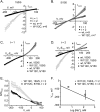Intrinsic voltage dependence of the epithelial Na+ channel is masked by a conserved transmembrane domain tryptophan
- PMID: 19620245
- PMCID: PMC2757952
- DOI: 10.1074/jbc.M109.015917
Intrinsic voltage dependence of the epithelial Na+ channel is masked by a conserved transmembrane domain tryptophan
Abstract
Tryptophan residues critical to function are frequently located at the lipid-water interface of transmembrane domains. All members of the epithelial Na+ channel (ENaC)/Degenerin (Deg) channel superfamily contain an absolutely conserved Trp at the base of their first transmembrane domain. Here, we test the importance of this conserved Trp to ENaC/Deg function. Targeted substitution of this Trp in mouse ENaC and rat ASIC subunits decrease channel activity. Differential substitution with distinct amino acids in alpha-mENaC shows that it is loss of this critical Trp rather than introduction of residues having novel properties that changes channel activity. Surprisingly, Trp substitution unmasks voltage sensitivity. Mutant ENaC has increased steady-state activity at hyperpolarizing compared with depolarizing potentials associated with transient activation and deactivation times, respectively. The times of activation and deactivation change 1 ms/mV in a linear manner with rising and decreasing slopes, respectively. Increases in macroscopic currents at hyperpolarizing potentials results from a voltage-dependent increase in open probability. Voltage sensitivity is not influenced by divalent cations; however, it is Na+-dependent with a 63-mV decrease in voltage required to reach half-maximal activity per log increase in [Na+]. Mutant channels are particularly sensitive to intracellular [Na+] for removing this sodium abolishes voltage dependence. We conclude that the conserved Trp at the base of TM1 in ENaC/Deg channels protects against voltage by masking an inhibitory allosteric or pore block mechanism, which decreases activity in response to intracellular Na+.
Figures










Similar articles
-
Voltage-dependent gating underlies loss of ENaC function in Pseudohypoaldosteronism type 1.Biophys J. 2011 Apr 20;100(8):1930-9. doi: 10.1016/j.bpj.2011.02.046. Biophys J. 2011. PMID: 21504729 Free PMC article.
-
A Na+ leak channel cloned from Trichoplax adhaerens extends extracellular pH and Ca2+ sensing for the DEG/ENaC family close to the base of Metazoa.J Biol Chem. 2019 Nov 1;294(44):16320-16336. doi: 10.1074/jbc.RA119.010542. Epub 2019 Sep 15. J Biol Chem. 2019. PMID: 31527080 Free PMC article.
-
Degenerin sites mediate proton activation of deltabetagamma-epithelial sodium channel.J Biol Chem. 2004 Jun 25;279(26):26939-47. doi: 10.1074/jbc.M401143200. Epub 2004 Apr 14. J Biol Chem. 2004. PMID: 15084585
-
Insight toward epithelial Na+ channel mechanism revealed by the acid-sensing ion channel 1 structure.IUBMB Life. 2008 Sep;60(9):620-8. doi: 10.1002/iub.89. IUBMB Life. 2008. PMID: 18459164 Review.
-
ASIC and ENaC type sodium channels: conformational states and the structures of the ion selectivity filters.FEBS J. 2017 Feb;284(4):525-545. doi: 10.1111/febs.13840. Epub 2016 Sep 15. FEBS J. 2017. PMID: 27580245 Review.
Cited by
-
Deficient transient receptor potential vanilloid type 4 function contributes to compromised [Ca2+]i homeostasis in human autosomal-dominant polycystic kidney disease cells.FASEB J. 2018 Aug;32(8):4612-4623. doi: 10.1096/fj.201701535RR. Epub 2018 Mar 19. FASEB J. 2018. PMID: 29553832 Free PMC article.
-
Dietary K+ and Cl- independently regulate basolateral conductance in principal and intercalated cells of the collecting duct.Pflugers Arch. 2018 Feb;470(2):339-353. doi: 10.1007/s00424-017-2084-x. Epub 2017 Nov 13. Pflugers Arch. 2018. PMID: 29134279 Free PMC article.
-
Voltage-dependent gating underlies loss of ENaC function in Pseudohypoaldosteronism type 1.Biophys J. 2011 Apr 20;100(8):1930-9. doi: 10.1016/j.bpj.2011.02.046. Biophys J. 2011. PMID: 21504729 Free PMC article.
-
ENaC structure and function in the wake of a resolved structure of a family member.Am J Physiol Renal Physiol. 2011 Oct;301(4):F684-96. doi: 10.1152/ajprenal.00259.2011. Epub 2011 Jul 13. Am J Physiol Renal Physiol. 2011. PMID: 21753073 Free PMC article. Review.
-
Structural mechanisms underlying the function of epithelial sodium channel/acid-sensing ion channel.Curr Opin Nephrol Hypertens. 2011 Sep;20(5):555-60. doi: 10.1097/MNH.0b013e328348bcac. Curr Opin Nephrol Hypertens. 2011. PMID: 21709553 Free PMC article. Review.
References
-
- Kellenberger S., Schild L. (2002) Physiol. Rev. 82, 735–767 - PubMed
-
- Garty H., Palmer L. G. (1997) Physiol. Rev. 77, 359–396 - PubMed
-
- Bianchi L., Driscoll M. (2002) Neuron 34, 337–340 - PubMed
-
- Lifton R. P., Gharavi A. G., Geller D. S. (2001) Cell 104, 545–556 - PubMed
-
- Bonny O., Hummler E. (2000) Kidney Int. 57, 1313–1318 - PubMed
Publication types
MeSH terms
Substances
Grants and funding
LinkOut - more resources
Full Text Sources

